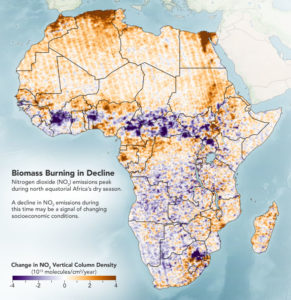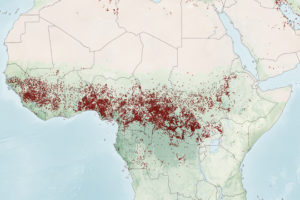Despite growing use of fossil fuels in many African countries due to development and economic growth, there has been a small but unexpected decrease in air pollution over some parts of the continent in recent years. According to new research, the change is most evident during the dry season in areas where grassland fires traditionally occur. The small seasonal decrease may not be enough to offset increasing human-caused air pollution in the long term, but it does show an interesting shift in the region.
Researchers from the U.S., France, and Cote d’Ivoire analyzed satellite observations of air pollution from 2005 to 2017. They found that nitrogen dioxide (NO2) concentrations over the northern grassland region of su
b-Saharan Africa dropped by 4.5 percent during the dry season (November through February).
NO2 is released as a byproduct of burning fossil fuels for electricity or transportation; from burning vegetation like grasslands or crops; and by the activity of soil microbes. The gas can cause or aggravate respiratory illnesses in humans and also can increase the formation of airborne particulates and ozone close to Earth’s surface.

The map above, derived from data collected by NASA’s Aura satellite, depicts changes in NO2 concentrations over Africa during November through February between 2005 to 2017. The natural-color image and map below displays fire detections and smoke in the region during a typical February, as observed by the Visible Infrared Imaging Radiometer Suite (VIIRS) on the Suomi NPP satellite.
Though the pollution decrease around equatorial Africa was small, it was unexpected because economies and urbanization have been growing in the region, and with it, fossil fuel consumption. The scientists attributed the change to a decrease in wildfires and controlled burns in grasslands during the dry season. The total area of savanna burned in sub-Saharan Africa is getting smaller each year as more people move into densely populated cities and towns, and as farming techniques and agricultural land use changes.
Lead author Jonathan Hickman, a postdoctoral fellow at NASA’s Goddard Institute for Space Studies (GISS), cautions that this positive trend may continue only to a point. Eventually, there may be a net worsening of air quality as pollution from fossil fuel burning surpasses the seasonal decline in fires.

14 February, 2020
Story cross-posted from NASA Earth Observatory
NASA Earth Observatory images by Lauren Dauphin and Joshua Stevens, using VIIRS data from NASA EOSDIS LANCE, GIBS/Worldview and the Suomi National Polar-orbiting Partnership, and data courtesy of Hickman, J. E., et al. (2021). Story by Sofie Bates, NASA Earth Science News Team, with Mike Carlowicz.